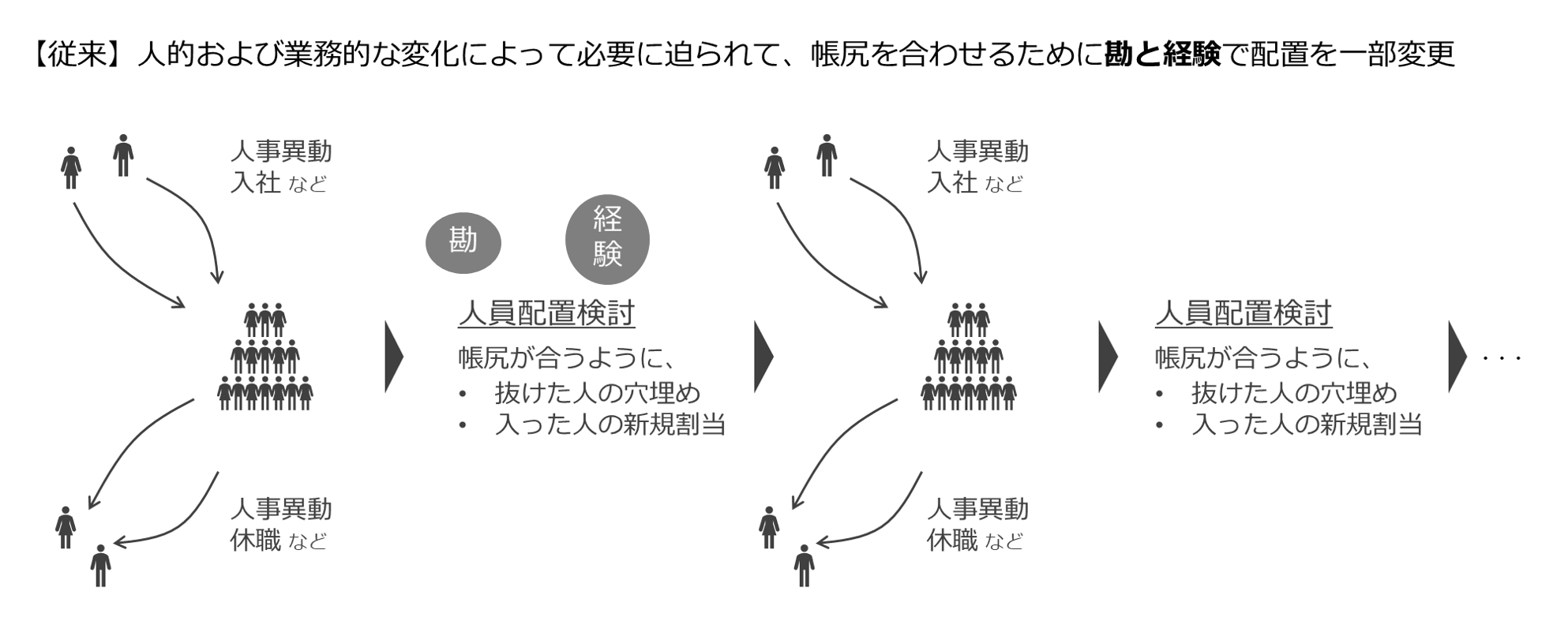
Hello, this is Ikeda from Macnica. My job is usually to use data to solve problems.
Recently, a certain department in Macnica has been working on solving the problems of "time-consuming staff allocation" and "difficulty in judging the appropriateness of staff allocation" by using AI, one of its core technologies. Mathematical optimization We have begun internal digital transformation activities to solve this problem by developing automation tools using this technology.
As shown in the figure below, we aim to move away from relying solely on intuition and experience when considering personnel allocation, to automatically create allocation plans based on quantified results and estimates.


In this article, I can't say that it was a spectacular 100% success, but I would like to introduce a story where value was born in a place different from what was expected as we proceeded with in-house DX step by step.
I would be happy if it would be helpful for everyone involved in in-house DX.
Overview
- I tried creating a staffing automation tool using Macnica in-house DX, but in the process of creating it, the staffing plan for this term was completed without the tool.
- More important than the tool itself was the introduction of a scheme to quantify the information necessary for layout studies on site.
- By experiencing the value of in-house DX on site, realistic and effective DX promotion ideas have come out from the site.
table of contents
- Conventional internal issues
- Assumptions for this in-house DX project
- 現状までの成果(当初の想定と異なる効果)
- future plan
- At the end
Series article introduction
- Staffing DX ~Part 1~: DX of staffing starting with Python and mathematical optimization
- Staffing DX ~Part 2~: Prototyping a staffing optimization app with Docker and Python
- Staffing DX ~Part 3~: ?This article
Conventional internal issues

Imbalance of working hours in clerical work
- In a certain back-office department within Macnica, there was an imbalance in employees' working hours for clerical work.
However, since the working hours for various clerical tasks differ depending on the employee's employment status and the degree of concurrent work,it was not possible to specifically grasp where and to what extent the imbalance occurred.
Placement based on intuition and experience
- Assignment of personnel to various clerical work was carried out based on intuition and experience.
Passive repositioning
- Every time there was a change in resources such as personnel additions or transfers, we implemented a small relocation to balance the changes that occurred.
Assumptions for this in-house DX project

This project does not aim to completely solve all of the above issues.
First, while discussing with the person in charge of the site, we came up with ideas and selected ideas that can achieve relatively high effects by spending a little time and money (cost).
If this project reaches practical use, the implemented contents Horizontal deployment to other departments by doing Low cost, high efficiency and conceived the steps shown in the figure below. Eliminate imbalances in working hours embarked on a project for
現状までの成果(当初の想定と異なる効果)

Developed deployment automation tools, but performed most deployments manually
In order to realize personnel allocation with less unevenness in work load, we developed a personnel allocation automation tool using this term's allocation decision as an initial use case, but this time we did not use the automatic allocation creation function of the developed tool. I did.
The best result is the idea of arranging based on numbers, not just intuition and experience
In the process of tool development, "the idea of assigning personnel based on numbers" was introduced to the field, and the preparation of a scheme for quantifying various working conditions with Excel was more important for the field than the tool development itself. It's been a big change.
In fact, while I was preparing to quantify working conditions in Excel, I was able to create most of the personnel assignments for this term based on numbers (happy? Miscalculation).
Leverage placement automation tools to make suggestions for “doesn’t matter” situations
For the rest of the parts where the placement was not decided, we used the automation tool to make suggestions for places where humans would not be able to base their placement decisions on ``either seems to be fine''. .
I was able to let people in the field experience the value of in-house DX activities.
Even if only people who are familiar with data and systems come up with ideas and take action, the project will not progress unless the value is communicated to the people in the field.
In this activity, the intuition and experience of the site were actually converted into data, and it was the first step for the site to experience the approach of solving small problems. I think it should be something.
Unlike at the beginning of the project, I think that the fact that people in the field have come up with realistic and effective ideas is also an effect of the experience of this project.
future plan

I want to detect imbalances in the workload and actively change the allocation.
Automation has reduced the time it takes to devise placements, and staffing biases can now be estimated numerically.
As a result, we believe that it will be possibleto detect imbalances in work loads and proactively consider relocation beforeevents such as personnel transfers of employees are required.
At the end
Staffing DX This series will be over for the time being, but I will try to write an article when I have more material.
If you haven't read the first article here for the mathematical optimization of the staffing DX project, and the second article here for the prototyping of web applications using Streamlit, I'd be happy if you could read it.
Kazuki Igeta